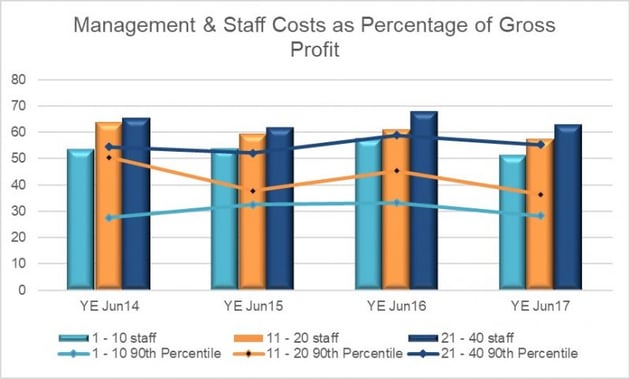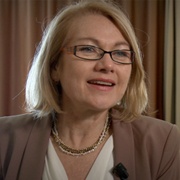Recruitment Firms Who Plunge into the Valley of Death

Rod Hore from HHMC Global recently caught up with Paula O’Connell of Oconsult to discuss the different financial models used in the recruitment industry.
We agreed that a major area of concern for business owners of smaller recruitment companies is balancing staff remuneration and profitability. It should be. For those who do not manage staff costs and staff performance tightly will find themselves in the recruitment Valley of Death in the next economic downturn.
What is the Valley of Death? When a business owner is paying out the commission to well supported and underperforming consultants but the company is making a loss.
The data doesn't lie - staff are costing too much
When staff are costing too much it can be for one of two reasons - they are on a package that is in excess of the gross profit being generated, or they are underperforming. The result is the same; the company is put at risk.
 The above data from the RIBreport shows that over the years, and across different company sizes, the problem continues. The bar chart shows that companies with a staff size of 1-10 on average are paying 54% of generated gross profit in management and staff costs. All remaining expenses and profit must be generated out of what remains.
The above data from the RIBreport shows that over the years, and across different company sizes, the problem continues. The bar chart shows that companies with a staff size of 1-10 on average are paying 54% of generated gross profit in management and staff costs. All remaining expenses and profit must be generated out of what remains.
It is worse for companies with 11-20 staff, where average management and staff costs are close to 60%, and worse again for companies with 21-40 staff where the average staff cost explodes to nearly 65%.
This is unsustainable and puts the average company in serious risk.
The best companies, those at the 90th percentile of the benchmark, are able to manage their management and staff costs, ranging from 31%, 43% and 55% across the three company size groups. We'd contend that 55% is still too high, but these results show what can be achieved with sensible employment structures combined with strong performance management.
How did this happen?
The recruitment model has continued to evolve with consultants now operating as candidate managers and job fillers, PSA managers and 360 degree consultants to name a few. Remuneration packages, however, have not evolved; with some consultants earning up to 50% of billings and the majority still operating on the basis of a third of their individual earnings.
This model can work well if a consultant operates truly as a 360o consultant with their own new business development responsibility, however, all too often, it is the business owner who is the "rainmaker" and the consultants purely delivery, supported by expensive marketing and resourcing.
Recruitment firms that have grown beyond 10 – 15 staff face the added challenge of management structures to manage their business and can find that bigger is not always better, especially when they are still using old style remuneration models.
Weighing up the risks
These old style remuneration models are dangerous for a number of reasons.
Business owners can over-invest their time to carry underperforming consultants. Especially with smaller firms, lack of performance and delivery of a consultant is often trumped by a cosy relationship or inherent trust that they can do their job. “We’re all grown ups here” is a common mantra.
Related: Competitive Advantage: Insights from Fast-Growing Staffing Firms
This issue can be masked as business owners are often not salaried within their own company. They rely on the actual company profit as their income, which really means that the company is only operating at break-even at best.
But it’s not just about business viability. Should you plan to sell your business at some stage, then new business development needs to be part of the overall process and not just generated by the principals of the business.
Changing the conversation with your consultants is always a challenge – what to do? No one wants to go back to their junior days of completing job activity forms, however, to increase your consultant productivity is to also increase your business profitability as well as insure for times of a market slowdown.
Options to consider include:
- Renegotiate salaries and bonuses based on the type of work that the consultant is working on – company referred or new business generated – and the support they receive.
- Arrange a salary for consultants who are managing key accounts that reflect the importance of their work without a business development component.
- Talk to your consultants every quarter on their billings and how this parallels to their total income. This can highlight where they need to step up and provide data for any difficult decisions you may need to make in the longer run.
- Set commission and bonus structures so that company expenses are covered by discretionary payments are made. A consultant has to contribute to non-billing staff, rent, IT, and all other expenses.
- Ensure, as a business owner, you allow for an appropriate salary for yourself in your P&L – this will then truly reflect the profitability of your business and help see the impact of carrying overpaid consultants.
- Share the top line company P&L with your staff – so that they can see the overall performance and impact that they have. Agree as a team the target profitability for the company with a shared bonus for overachieving it.
- Assess the optimal size for your business and whether growing your company will mean increased management costs and less profitability.
Staffing costs will always be the biggest expense of a recruitment business and should be your best investment. But it is an investment that you have to manage smartly to keep your business from plunging into the Valley of Death.
 Paula O'Connell set up Oconsult in 2017 to provide strategic business counsel to business owners of small recruitment firms. She has recently returned to Sydney after 15 years in the Netherlands where she established, grew and sold an executive search firm specialising in international marketing. Paula began her recruitment career with Morgan and Banks in the 1990s where she built the interim marketing practice for the Sydney office. She brings expertise in business planning, company analysis, competitor analysis, positioning, growth strategy, exit strategy, business development planning and process audit reviews.
Paula O'Connell set up Oconsult in 2017 to provide strategic business counsel to business owners of small recruitment firms. She has recently returned to Sydney after 15 years in the Netherlands where she established, grew and sold an executive search firm specialising in international marketing. Paula began her recruitment career with Morgan and Banks in the 1990s where she built the interim marketing practice for the Sydney office. She brings expertise in business planning, company analysis, competitor analysis, positioning, growth strategy, exit strategy, business development planning and process audit reviews.


 By
By


